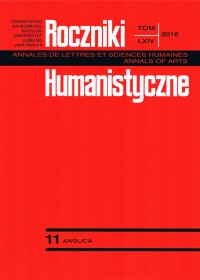“[A] window into the city’s underlying fabric”: Bouncing at the edge of the global metropolis in William Gibson’s Bigend Trilogy
Abstract
In the article, I examine the descriptions of the globalized urban landscape found in William Gibson’s Bigend Trilogy (Pattern Recognition (2003), Spook Country (2007), Zero History (2010)) and argue that in the socioeconomic reality Gibson projects the global metropolis functions as both a global facilitator and a global bouncer acting on the premise of selective inclusiveness. In the article, I first argue that in the Bigend Trilogy cities act as the enablers (or enforcers) of the global flows, and, what is often overlooked, are thus complicit in all the grounding (and often villainous) processes of globalization. Subsequently, I develop some critics’ ideas about Gibson’s presentation of the urban consequences of global exchange, and conclude that in the trilogy global metropolises are the frontline for the confrontation of globalization and local idiosyncrasies, and portend the advancing global homogenization. Finally, I compare Gibson’s analyses of the post-millennial metropolis and the 20th-century edge city. Just like once edge cities, I propose, the global metropolis prides itself as the new Territory of American civilization; the opportunity it offers, Gibson illustrates, is, however, equally illusory and reserved only for the privileged minority.
References
Augé, Mark. Non-Places: Introduction to an Anthropology of Supermodernity. Trans. John Howe. London and New York: Verso, 1995. Print.
Abbot, Carl. “Cyberpunk Cities: Science Fiction Meets Urban Theory.” Journal of Planning Education and Research 27 (2007): 122–131. Print.
Garreau, Joel. Edge City: Life on the New Frontier.New York: Anchor Books, 1992. Print.
Gibson, William. Pattern Recognition. London, UK: Penguin Books, 2004. Print.
Gibson, William. Spook Country. London, UK: Viking, 2007. Print.
Gibson, William. Zero History. London, UK: Penguin Books, 2010. Print.
Jarvis, Ben. “‘It is always another world’: Mapping the Global Imaginary in William Gibson’s Pattern Recognition.’”Land & Identity. Theory, Memory and Practice. Eds.: Berberich, Christine, Campbell, Neil, Hudson, Robert. Amsterdam: Radopi, 2012. 235-257. Print.
Link, Alex. “Global War, Global Capital, and the Work of Art in William Gibson’s Pattern Recognition.” Contemporary Literature 49.2 (2008): 209–231. Print.
Purdon, James. “Zero History by William Gibson.” The Guardian, http://www.theguardian.com/books/2010/sep/12/Zero History-history-william-gibson-book-review. Accessed Dec 12, 2015.
Suzuki, Shigeru. “A Requiem for the Fall of the Petal.” American Book Review 25.1 (2003): 31. Print.
Wetmore, Alex. “The Poetics of Pattern Recognition: William Gibson’s Shifting Technological Subject.” Bulletin of Science, Technology & Society 27.1 (2007): 71–80. Print.
Copyright (c) 2016 Roczniki Humanistyczne

This work is licensed under a Creative Commons Attribution-NonCommercial-NoDerivatives 4.0 International License.





